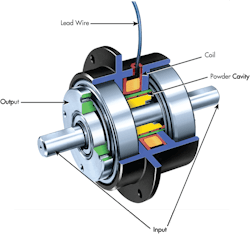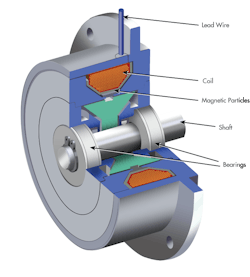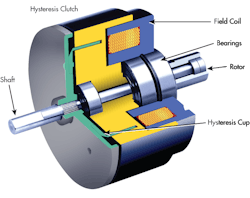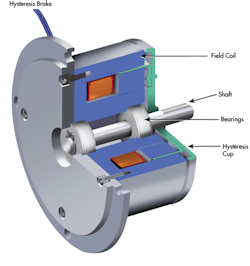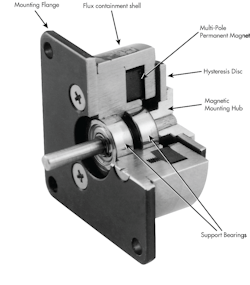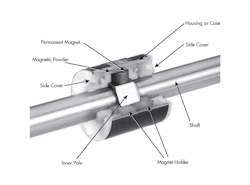What’s the Difference Between Torque-Control Solutions?
Download this article in PDF format.
Electric clutches may not be always the engineer’s first choice when looking at torque-control solutions. Electric motor drive systems, pneumatic clutches, or even friction spring types are thought of first, but certain unique styles of electromagnetic clutches lend themselves very well to tension and torque control. They basically fall into two categories: powered and non-powered.
Powered Units
Magnetic particle clutches
These clutches are typically found in applications that prefer controlled slip or controlled slip speeds. Often used for tensioning in winding applications, these clutches have very precise, electrically controlled variable torque. Since torque is controlled by varying current, torque will not vary across changing slip speeds. When used per design recommendations, they feature smooth, repeatable torque.
To engage the clutch, current is applied to the field coil, creating an electromagnet that results in magnetic flux. Small magnetic particles (ceramic-coated pieces of steel) in the open clutch cavity attract to each other along the lines of flux. Normally, the input and output parts of the clutch are separate, but when the particles bind together, they start to attract to each other and rotation is transferred from the input to the output.
Magnetic particle clutch
The torque is proportional to the current applied, which gives these clutches an accurate controlled torque. This means they can provide a soft start in an application, and since they can slip, they can also be used as overload protection. If the output torque exceeds the torque set in the clutch, the clutch will slip, protecting the output.
To disengage the clutch, the current is removed. The magnetic flux lines drop out and the magnetic particles stop trying to bind together. All that remains is a small amount of drag. The input and output are essentially free to rotate independently, except for some remaining particle drag.
Maximum speed ratings and heat dissipation are important factors to consider when sizing a magnetic particle clutch. As speed and torque escalate, it also increases slip wattage. Some of the larger units are equipped with ports for forced-air cooling or require fans to help with heat dissipation. Overall, these are fast-response devices with stable torque, long life, and the ability to perform under constant slip.
Magnetic particle brakes for tension control
With these brakes, you can literally dial in your desired torque. Often used for tensioning in unwinding applications, these brakes have electrically controlled variable torque. Since torque is controlled by varying current, torque does not vary across changes in slip speeds.
Magnetic particle brake
The coil is energized, becoming an electromagnet and producing electromagnetic lines of flux. The magnetic particles (which are very small, ceramic-coated pieces of steel) inside the brake cavity align themselves along the lines of magnetic flux (similar to iron filings around a magnet). The particle chain extends from the coil/field assembly (fixed) to the inner hub (which is attached to the output shaft and input rotating). Those magnetic particle chains create drag/torque from the input to the output. The drag that’s transferred is proportional to the input current.
When the coil is de-energized, it discontinues the magnetic flux. The field assembly and output shaft no longer interact with each other, except for a small amount of drag. These brakes can be designed to run under continuous slip to provide tension control in common applications like wire, film, and tubing. The limiting factor is typically heat dissipation. For this reason, some of the larger or higher wattage requirements incorporate additional cooling, such as a built-in fan or ports for air cooling.
Hysteresis clutches and brakes for torque and tension control
Hysteresis clutches and brakes transmit torque magnetically. Rotating parts in a clutch, or stationary parts in a brake, do not come in contact. Torque is directly proportionate to coil current; thus, the torque of each unit can be controlled very accurately over a very wide operational range. Once current is stable in the clutch or brake, the torque remains constant.
No wear occurs to the surfaces that are transmitting the torque, which translates into extremely long lifetimes for these units. Also, no wear points means that there’s no maintenance. On top of that, there aren’t any magnetic particles in the units, so they can operate horizontally or vertically.
Hysteresis clutch
To engage the clutch or brake, current is applied to the field coil, which creates magnetic flux. In a clutch, the rotor carrying the flux rotates around a hysteresis disc or cylinder (in a brake, there’s no rotor, just the disc). As the current increases in the clutch or brake, it strengthens the magnetic attraction to the permanent magnet disc. This, in turn, transmits rotation in the case of a clutch, or acts as a retardant in the case of a brake.
Electromagnetic hysteresis brake
To disengage the clutch or brake, simply remove current. Both brakes and clutches can be designed to run with continuous slip, which makes them ideal for tension-control applications in fine wire or for testing equipment such as simulating loads for small motors.
Non-Powered Units
PHT (permanent magnet hysteresis)
Depending on the mounting method, these units can function as either a clutch or brake. Torque is magnetically generated, but is a function of the unit’s mechanical setting. Each unit has an individual torque range. Once that torque is set, torque is generally stable regardless of speed (within the unit’s speed range). As a result, the units are ideally suited for tension-control applications. Paper, film, foil, wire, and other material tensions can be easily controlled.
These units do not require a power supply, which makes them a very cost-effective option. Typical applications include motor test stands, wire winding, bottle-cap machinery, and labeling equipment. Because the units are sealed and do not develop wear particles, they are well-suited for medical and food-processing equipment.
PHT—Permanent magnet hysteresis brake/clutch
Most units contain a hysteresis disk, which is directly attached to the hub that passes through the clutch/brake. Two circular multiple pole magnets are solidly attached internally within the unit. The magnets face each other with the hysteresis disk between them. An air gap exists between the magnets and the hysteresis disk, so the hysteresis disk can turn without any frictional contact. The opposing circular magnets set up magnetic flux, which causes drag on the hysteresis disk. That, in turn, causes drag to the bore or shaft in the unit.
The amount of output drag can be increased or decreased with the manually adjustable units. When the magnet poles are aligned north to north and south to south with each other, they produce the maximum amount of drag on the disk. As the poles are changed from a north to south alignment, the flux passes directly through the hysteresis material, reducing the amount of drag on the bore of the unit’s shaft.
Hybrid slip clutches
Commonly used in paper-feeding applications like copy machines and printers to prevent paper jams and misfeeding of paper sheets, these slip clutches are actually rather simple.
Most slip clutches are mechanical, but OPL clutch developed by Ogura has a unique design. It is a hybrid between a permanent magnet and a magnetic particle clutch. In this clutch, multiple-pole magnets are solidly attached to a rotor shaft. The magnet/shaft assembly turns relative to the housing, which is magnetic high carbon steel. An airgap between the rotor and the housing contains magnetic particles. The magnets on the rotor create magnetic flux lines across alternating magnetic poles. The magnetic flux tries to bind the particles together.
The magnetic particles form chains along the flux lines between the magnets and the housing, which causes a smooth drag torque when rotated. The housing is normally connected to a gear or pulley. Either the shaft/bore of the unit or the housing (gear/pulley) can be the input or the output.
The OPL-N hybrid slip clutch
These clutches come in bushing or ball-bearing design, with or without a shaft. They achieve the best repeatable performance when used in horizontal applications. These clutches normally produce very little internal wear and will provide very stable torque to help improve the life of the machine.
The units are sealed, which prevents particles from getting out of the device, but it also prevents environmental contaminants from getting in. They are easy to install because the units come preassembled to a preset torque value, so there is nothing for the user to adjust.

